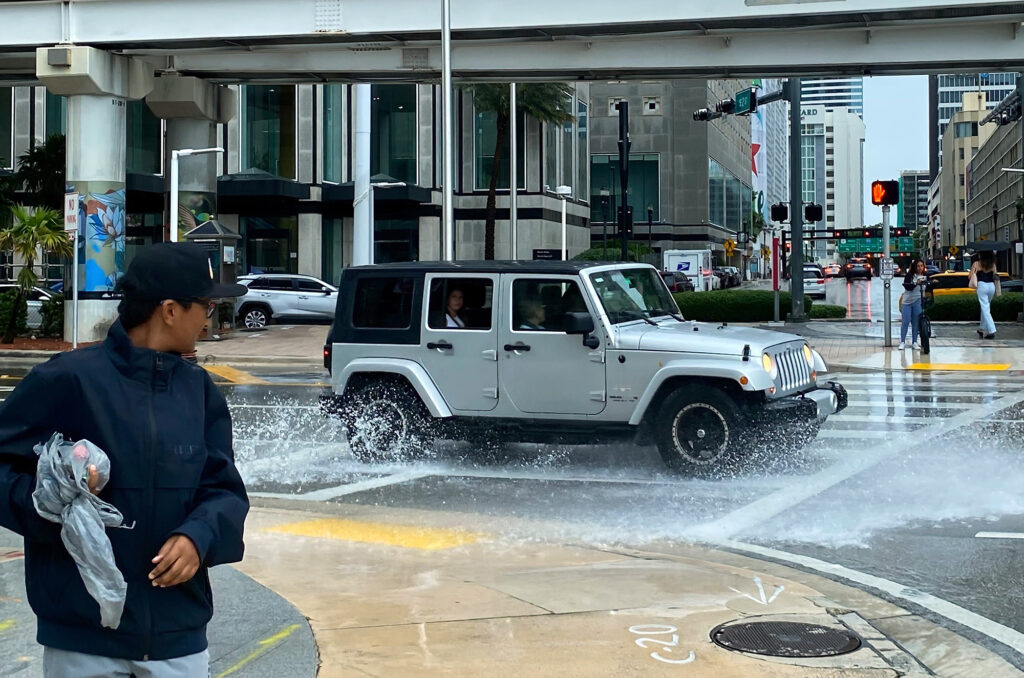The world is getting hotter. The way journalists talk about the crisis is key.

Florida has been unbearably hot this summer. Much of the state has been under heat advisories, with local governments cautioning people to stay inside as much as they can. Major cities in the south, like Miami, have felt three-digit temperatures for weeks.
Nicolás Rivero, the climate change reporter for the Miami Herald, has focused on chronicling what this means for people who work outdoors, such as roofers and farmers, despite the warnings.
These are climate change stories, but he said he tries to avoid framing them as such.
“I think the more that you can make it concrete and talk about how it’s affecting daily lives already, you can get people to pay attention,” said Rivero.
The distinction might seem minimal, but as the crisis and its related skepticism intensifies at the same time, the way journalists tell these stories is key, reporters and experts told the Latino Reporter.
“I think it’ll be like the overriding story of our lifetime,” Rivero said. “A lot of these impacts, at this point, are already being felt in people’s daily lives in South Florida. And it will be for more of the country going forward.”
The average temperature of the Earth’s surface has increased about 1.1 degrees Celsius since the late 1800’s, a change that has led to issues including, water scarcity, severe fires and catastrophic storms across the globe, according to the United Nations.
“There has been such a dramatic increase in extreme weather events that are being driven by the climate, global heating and the climate crisis,” said John Morales, the founder and lead certifying consultant meteorologist for ClimaData.
And journalists have to cover all of the above.
Yvette Cabrera, the president of the National Association of Hispanic Journalists and an investigative reporter who specializes on environmental justice, said that communicating the urgency of climate change is especially important for journalists because the issue is “not going away.”
She said that organizers were cognizant that they were holding the annual conference in Miami, a city facing climate-related threats such as rising sea levels and more hurricanes — all of which often hit brown and Black communities, those marginalized, the hardest.
“We wanted to address the fact that we’re in a place where this is very much a challenge,” she said during a press conference with Latino Reporter this week.
This year, she said, organizers were intentional to include a range of panels and resources on the topic for journalists, especially for those who are not already covering the beat.
Across the industry, it’s well known that climate coverage can sometimes be as difficult as it is important.
Rivero said that data and jargon can be especially intimidating, even for him. He suggested knowing a few key facts, things like specific peak temperatures or how many inches the sea has risen in a specific area, and talking to experts for the rest.
Covering the topic can also be difficult as climate change has been politicized.
Last month, Chris Gloniger, a meteorologist from Iowa, made national headlines when he resigned from Des Moines’s CBS TV station affiliate KCCI to focus on climate advocacy.
“After death threats stemming from my climate coverage last year and resulting PTSD, in addition to family health issues, I’ve decided to begin this journey now,” he tweeted on June 21.
As challenging as it may be, for Adi Guajardo, a national correspondent for Scripps news, climate-coverage is worth doing.
“I think some people are intimidated, the moment that they hear ‘climate change;’ they think science, they think numbers, they think data, things that may be out of their realm,” said Guajardo. “But if we can simplify it on multiple platforms, I think we have a generation, we have viewers that are better informed and know how to make decisions within their community to try to create an impact.”
At her first job in Eugene Oregon, she remembers it being very hot one summer, but she was still new to the area and wasn’t sure whether it was the norm.
She learned from her editors that these waves were new and hard to manage, especially for families that didn’t have air conditioning and now needed to save up for them. So, she decided to tackle the topic by gathering the data behind what was happening and combining that with stories of people struggling the most
She said combining data with relatable narratives is what ultimately makes for good climate coverage.
“That resonates with people,” said Guajardo. “When you put people in the story, when people hear people’s stories, that helps them understand the data.”
Tips for journalists entering the environmental field:
- Make sure you know a few key numbers, things that resonate, and to try to tie stories back to industries that people care about: prices going up, tourism going down, anything that expresses the urgency of the impact of climate change. — Nicolás Rivero.
- Use extreme caution when navigating attribution: “Journalists need to understand that the scientific process does not yield solutions, it yields a consensus, a fact-based finding.” — John Morales
- Seek expert explanations and avoid the urge to look for incorrect statements just for “balance.”
And seek out resources such as Climate Central’s, a weekly bilingual newsletter, Climate Matters.
Aisha Baiocchi is a junior at UNC-Chapel Hill and Duke University studying journalism and international comparative studies. Reach her at aisha_bee [at] me [dot] com and on Twitter @_aishabee_.